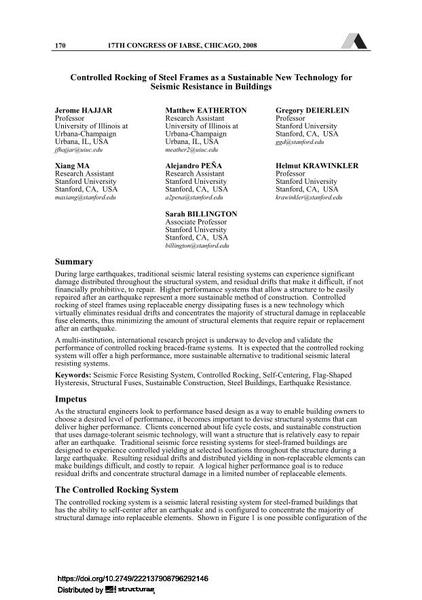Controlled Rocking of Steel Frames as a Sustainable New Technology for Seismic Resistance in Buildings

|
|
|||||||||||
Détails bibliographiques
| Auteur(s): |
Jerome Hajjar
Matthew Eatherton Gregory Deierlein Xiang Ma Alejandro Pena Helmut Krawinkler Sarah Billington |
||||
|---|---|---|---|---|---|
| Médium: | papier de conférence | ||||
| Langue(s): | anglais | ||||
| Conférence: | 17th IABSE Congress: Creating and Renewing Urban Structures – Tall Buildings, Bridges and Infrastructure, Chicago, USA, 17-19 September 2008 | ||||
| Publié dans: | IABSE Congress Chicago 2008 | ||||
|
|||||
| Page(s): | 170-171 | ||||
| Nombre total de pages (du PDF): | 8 | ||||
| Année: | 2008 | ||||
| DOI: | 10.2749/222137908796292146 | ||||
| Abstrait: |
During large earthquakes, traditional seismic lateral resisting systems can experience significant damage, which is distributed throughout the building, and residual drifts that make it difficult and often uneconomical to repair. Higher performance systems that allow a structure to be easily repaired after an earthquake represent a more sustainable method of construction. Controlled rocking of steel frames using replaceable energy dissipating fuses is a new technology which virtually eliminates residual drifts and concentrates structural damage in replaceable fuse elements, thus making repairs easier and less-costly after an earthquake. A multi-institution, international research project is underway to develop and validate the performance of the controlled rocking system. It is expected that the controlled rocking system will provide the structural engineering community with a high performance, more sustainable alternative to traditional seismic lateral resisting systems. |
||||
| Mots-clé: |
construction durable
|
||||
